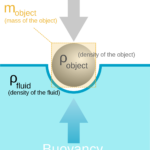What causes the air to blow from place to place? Is there a giant ogre hiding in a cave somewhere blowing out birthday candles, or is something else at work? As you probably guessed, it is the latter.
Air movement is caused by differences in pressure from one location to another in the Earth’s atmosphere. It is the atmosphere trying to equal out pressures.
Consider a cup of water. What happens when you turn a cup of water upside down on a table? Unless the water is frozen into a solid chunk of ice, the water will flow outward into a puddle. It is impossible to make the liquid water retain the shape of the cup once the cup is removed. This is because without walls holding the water in, the liquid’s natural reaction is to flow as far outward as possible.
Unlike liquids, gases don’t stop once they reach the puddle stage. They keep spreading outward as far as possible. Without walls to hold them in, a gas will continue spreading outward forever, or until they run into other forces.
The only force acting to hold the gases in on Earth is gravity. Thus, all the gases of our atmosphere try to spread out until they are equally dense all around the globe. We call this balance homeostasis. These gases should have reached this state of homeostasis many billions of years ago. So why are things still blowing around today? There are important forces at work that keep the atmosphere from ever being able to stabilize.
The main force responsible for the inability of the gases of the Earth’s atmosphere to stabilize is the unequal heating of one portion of the atmosphere compared to another by the Sun.
Wind Movement
Because wind is caused by the gases of the Earth’s atmosphere moving about in an attempt to equalize pressure, it seems natural to assume that wind would blow outward from areas of high pressure, towards areas of lower pressure. In a perfect world, free from other influences, this would indeed be the case. However, sometimes other factors can cause wind to blow differently than this expected pattern.
Three important factors affect the direction that wind blows. These factors are pressure gradient, the Coriolis effect, and friction.
Pressure Gradient
A gradient is a gradual change from one thing to something else. It is easy to understand this concept by considering the colors black and white. To create a gradient between them, we begin with the color black. Slowly the color changes across the picture from black to dark gray. The gray becomes lighter and lighter, until finally it turns into white.
A pressure gradient starts with a high pressure. Slowly the pressure exerted by the atmosphere becomes less and less until it is very low. As we move further away from the area where the center of the high pressure is located, we travel through that pressure gradient, reaching the low pressure.
As we have discussed earlier, wind is caused by the gases of the atmosphere as they move from one place to another in an attempt to equalize pressure. Thus, wind often blows outward from a high pressure location towards lower pressures. Free from other factors, it would always behave this way.
The Coriolis Effect
The rotation of the Earth causes an interesting phenomena on free moving objects on the Earth. Objects in the Northern Hemisphere are deflected to the right, while objects in the Southern Hemisphere are deflected to the left.

The coriolis effect thus tries to force winds to shift towards the right or left. The coriolis effect can at times cause winds to blow back up the pressure gradient.
The coriolis effect and pressure gradient work against each other. Pressure gradient pushes winds outward, while the coriolis effect moves winds to the right or left. Often these two forces reach a balance, causing winds to blow sideways along the pressure gradient, not getting any further out from a high pressure or closer to a high pressure. This type of wind is known as a geostrophic wind.
Wind Friction
The final major factor affecting the direction that wind follows is friction. Near the surface of the Earth there a many things that interfere with wind, slowing it down, and changing its direction. These include trees, mountains, houses, buildings, lakes, oceans, and streams.
The effect of friction is only important near the surface of the Earth. The higher one travels into the atmosphere, the less obvious are the effects of friction. Above 5000 feet (1500 meters) winds almost always follow a geostrophic pattern, where they are balanced between the pressure gradient and the coriolis effect.
Wind Speed
Although occasionally other factors can impact the speed at which airflow travels, wind speed is primarily affected by the pressure gradient. If the pressure gradient is sharp, or in other words, if it changes rapidly from a high pressure to a low pressure, then the wind speed will almost always be high.
If the pressure gradient is gradual, then in almost all cases, the wind speed will be low.






